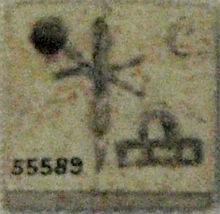Neithhotep
| Neithhotep | |||||
|---|---|---|---|---|---|
| Queen consort of Egypt | |||||
 Bone label of queen Neithhotep on display at the British Museum. | |||||
| Burial | Naqada, "Great Tomb" | ||||
| |||||
| Dynasty | 1st dynasty of Egypt | ||||
| ||
| Neithhotep [1] in hieroglyphs | ||
|---|---|---|
| Era: Old Kingdom (2686–2181 BC) | ||
Neithhotep (or Hetepu-Neith) was the first queen of ancient Egypt, cofounder of the First dynasty, and is the earliest woman in history whose name is known. The name Neithhotep means "[The Goddess] Neith is satisfied".
Biography
Neithhotep's dynastic marriage to Narmer, which could represent the start of the Early Dynastic Period of Egypt, c. 3200 BCE with the unification of Lower and Upper Egypt, may be represented on the Narmer Macehead.[2] Indeed, in this view Neithhotep was originally a princess of Lower Egypt, before marriage to Narmer (Thinite king of Upper Egypt). An alternative theory, based on the location of her tomb, holds that Neithhotep was a member of the royal line of Naqada.
Neithhotep was the wife of Narmer[1][3] or wife[4] or mother of Hor-Aha and possibly the mother of Benerib, Hor-Aha's wife.
Neithhotep's name was found in several locations:
- Clay sealing in the tomb at Naqada with the name of Hor-Aha and Neithhotep.[3][5]
- Clay sealing with the name of Neithhotep alone, also from the royal tomb in Naqada. Some of these are now in the Cairo Museum.[6]
- Two inscribed vases were found in the tomb of Djer, Neithhotep's grandson.[7]
- Ivory fragments with the name of Neithhotep were discovered in the subsidiary tombs near Djer's funerary complex.[7]
- A fragment of an alabaster vase with the name of Neithhotep was found in the general vicinity of the royal tombs in Umm el-Qaab.[8]
- On labels from Helwan.[3]
Her titles were: ḫntỉ (Foremost of Women), sm3ỉ.t nb.tỉ (Consort of the Two Ladies). Both were titles given to queens during the First dynasty.[1]
Tomb
Neithhotep tomb was a large mastaba first excavated by Jacques de Morgan [9] at the end of the 19th century and now lost due to erosion.

Vessel inscriptions, labels and sealings from the graves of both Hor-Aha and Queen Neithhotep suggest that this queen died during the reign of Hor-Aha and that she was his mother.[10] The selection of the cemetery of Naqada as the resting place of Neithhotep is a strong indication that she came from this province. This, in turn, supports the view that Narmer married her because she was a member of the ancient royal line of Naqada.[11]
References
- ^ a b c J. Tyldesley, Chronicle of the Queens of Egypt, 2006, Thames & Hudson
- ^ Walter B Emery, Archaic Egypt, Pelican Books,1961, ISBN 0-14-020462-8
- ^ a b c Aidan Dodson & Dyan Hilton, The Complete Royal Families of Ancient Egypt, Thames & Hudson (2004)
- ^ Grajetski Ancient Egyptian Queens: a hieroglyphic dictionary Golden House Publications, pg. 2
- ^ Porter and Moss Topographical Bibliography; Volume V Upper Egypt Griffith Institute, pg 119
- ^ Porter and Moss, pg 119
- ^ a b Porter and Moss, pg 78
- ^ Porter and Moss, pg 89
- ^ De Morgan Recherches sur les origines de l'Egypte II. Ethnographie préhistorique et tombeau royal de Negadah
- ^ Silke Roth: Die Königsmütter des Alten Ägypten von der Frühzeit bis zum Ende der 12. Dynastie. Wiesbaden 2001, S. 31–35
- ^ Toby A.H. Wilkinson: Early Dynastic Egypt. S. 291
